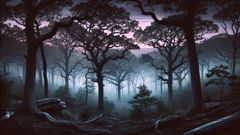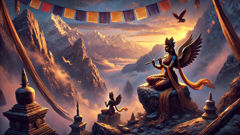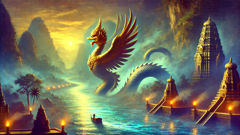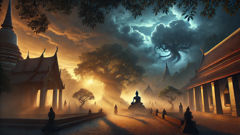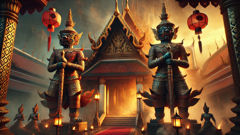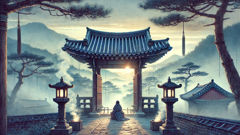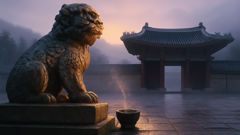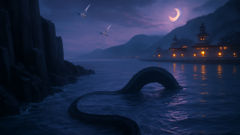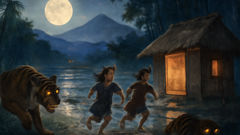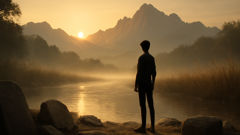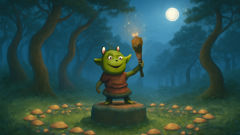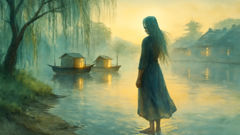Introduction
There’s a wildness to the Ozarks you can’t quite explain to someone who’s never walked beneath the hickories and oaks at dusk. The hills roll endlessly, cloaked in a shifting mist that softens the sharp outline of pine and bluff, and the air thrums with the memory of old stories. Here, in this ancient and tangled corner of Arkansas, legends root deep and bloom with the seasons. Of all these, none is so chilling or persistent as the legend of the Ozark Howler—a beast that’s haunted the dreams and conversations of locals for generations.
They say the Howler is massive, bear-like but darker, with coarse black fur and horns arching from its brow like a ram’s. Its eyes burn an unnatural red in the gloom, and its cry—neither wolf’s howl nor panther’s scream—splits the night with a sound that freezes the blood. Some claim it’s a spirit or demon, others a lost relic of another age, but everyone agrees: you don’t want to meet it alone in the dark.
Tourists sometimes come for the stories, sipping sweet tea on porch swings and hoping for a glimpse of the wild. Locals, though, lock their doors and leave offerings at the edge of the woods. The Howler is more than a campfire tale; it’s a force that shapes how people live with the land—what paths they avoid, what shadows they trust, what mysteries they’re willing to leave unsolved. Tonight, the mountains are restless. An owl stirs and takes flight, a distant branch snaps, and somewhere, far up in the hollows, a cry rings out—a deep, mournful sound, strange and ancient, that lingers long after the echo dies. And so our story begins.
Whispers in the Pines
Dr. Samuel Turner’s boots left shallow prints in the soft earth as he followed a narrow trail winding through the Ozark National Forest. The air was thick with the scent of moss and fallen needles, cool and damp against his skin. A wildlife biologist by trade, Sam had spent years unraveling the secrets of Arkansas’s wild places, but nothing had prepared him for the stories that brought him here this autumn.
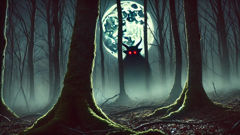
He’d heard them first at a diner in Jasper, over scrambled eggs and coffee so strong it could peel paint. An old-timer named Clyde had leaned in close, voice low. “You looking for bobcats? You might find something bigger. Something with horns.” The others had nodded, eyes darting toward the windows as if expecting the darkness itself to eavesdrop.
Sam’s work had always been grounded in observation and fact. He’d tracked black bears through bramble-choked ravines, mapped the migrations of warblers, and cataloged salamanders hiding under stones. The Howler, though—this was something else. He’d dismissed it at first as local color, a story grown wild in the telling. But the evidence had mounted: scat too large for a coyote, claw marks scored high in beech bark, and, most unsettling of all, recordings of an unidentifiable cry echoing through the valleys.
His curiosity wrestled with caution. The forest here was both beautiful and indifferent—sunlight dappled through the canopy in fleeting patches, and every so often he’d catch the metallic flash of a creek tumbling over rocks. He paused at the edge of a hollow, scanning the shadows. Something had moved—a ripple of blackness, or maybe just a trick of the light. He knelt, brushing away leaves to reveal a paw print, larger than any he’d seen in these hills. The claws arced forward, and at the tip of each impression, a curious gouge as if something hard—horn, perhaps—had grazed the soil beside it.
Sam’s heart thudded as he rose. The stories crowded his mind: of cattle mutilated in the night, of children returning home pale and trembling after glimpsing red eyes in the brush. His rational mind insisted there was an explanation—escaped livestock, an unusually large bear, a prankster with too much time. Yet the forest had its own logic, and as dusk bled across the ridges, he felt himself slipping deeper into its spell. The wind shifted. From somewhere high on the ridge, a cry rose up—low at first, then rising into a banshee wail. It was not like anything Sam had ever heard. He froze, every instinct urging him to run, but something stronger—wonder, maybe, or stubbornness—held him fast. He pressed deeper into the woods, his flashlight trembling as it swept across root and stone. The Howler was out there. He could feel it in the marrow of his bones.
The Echoing Cry
Sam pitched his tent on a flat patch of earth beside a trickling stream, careful to set it up before the last light slipped away. The forest grew dense at night, every tree pressing closer, every shadow stretching long fingers toward his little circle of lamplight. He listened, notebook in hand, scribbling down every rustle and chirp. Above the usual chorus of crickets and distant owls, something else hovered—a tension, like the woods themselves were holding their breath.
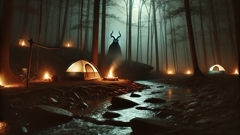
He replayed the audio recordings he’d collected: a series of howls that started low and mournful, then escalated into a shattering crescendo that seemed to rattle the very ground. Local hunters had dismissed it as a bobcat or cougar, but Sam’s analysis told another story. The frequency was wrong, the pitch too deep, and the pattern eerily consistent across dozens of sightings, sometimes separated by years and miles.
Unable to sleep, Sam took up his flashlight and followed the sound of running water upstream. The stones were slick beneath his boots, and the beam of light danced over tangled roots and brambles. Somewhere overhead, a barred owl called, its voice rising in the darkness like a question. Sam pressed on, heart pounding with each step. He was close to something—a truth he could almost touch.
Then he heard it: a branch snapping, close by. He spun around, shining the light into the thicket. For a split second, he caught a glimpse—a hulking shape, too large to be a bear, low-slung and broad-shouldered, with horns that swept back in a curve. Red eyes caught the light and flared. The creature did not flee; it watched him with a strange, deliberate patience, as if weighing him against the quiet order of the night.
Sam’s breath fogged in the cold air. He reached for his camera, but his hands trembled so badly he nearly dropped it. The creature shifted, powerful muscles rippling beneath its shadowy coat, then vanished into the trees with a soundless grace that belied its bulk. The woods closed in behind it, and the night swallowed the last trace of its passage.
Shaken, Sam stumbled back to camp. He tried to convince himself it had been a trick of moonlight and fear, but the memory of those eyes lingered. He knew he had seen something real—something that walked the thin line between nightmare and nature. That night, as he lay awake in his tent, the cry came again. This time, it was closer. It echoed through the ravines, weaving itself into his dreams. When dawn broke, painting the leaves in gold and green, Sam felt changed. He had crossed an invisible threshold, and there would be no turning back.
Between Fact and Folklore
Back in town, Sam’s encounter became the talk of the valley. News travels fast in small mountain communities, especially when it concerns old legends. People dropped by the general store to ask what he’d seen. Some brought gifts—a thermos of coffee, a worn field guide to local fauna—while others eyed him with suspicion or envy. The legend of the Howler had always belonged to them, and now an outsider had come too close to its heart.
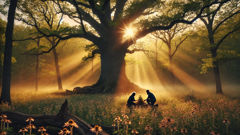
At the library, Sam pored over yellowed clippings and hand-drawn maps, tracing reports of the creature across decades. Descriptions varied—sometimes it had a mane like a lion, other times hooves instead of paws—but always the horns and that unearthly cry. Some stories were hoaxes or misidentifications, but others… they had a ring of truth that made Sam shiver.
He met with Becca Mason, a local historian whose family had lived in the Ozarks for generations. Over mugs of chicory coffee in her sunlit kitchen, she shared her own story. “My great-grandmother used to say the Howler was a guardian. Not evil, just old—a spirit that watched over these woods before there were roads and fences. Folks used to leave offerings at certain trees: a bit of bread, a shiny stone, a pinch of salt.”
Sam listened intently. “But why is it always seen as a threat?”
Becca shrugged. “That’s just fear talking. We’re not as close to the land as we once were. When you don’t understand something, you make it monstrous.”
Together, they hiked to a mossy glade deep in the forest—a place marked on no map, where old cedars leaned in close and wildflowers painted the ground. There, Becca placed a handful of cornmeal at the base of an ancient oak. “For respect,” she said. “For balance.”
As dusk fell, they heard movement in the undergrowth. Not the soft footfalls of deer or the scurry of raccoons—something heavier, more deliberate. Sam felt the hair on his arms stand up. They stayed very still, listening as a low grunt echoed through the trees. Then came the cry—so close it seemed to vibrate in their bones. Becca squeezed Sam’s hand, her face pale but determined. “Don’t run,” she whispered. “It means no harm if you stand your ground.”
Minutes stretched like hours, but the beast did not appear. Instead, a hush fell over the clearing—a sense of presence, powerful and ancient, yet oddly comforting. When they finally made their way back to town under a sky ablaze with stars, Sam felt he had glimpsed something sacred. The line between fact and folklore had blurred, and he no longer cared which side of it he stood on.
Conclusion
The legend of the Ozark Howler endures not because it can be captured or cataloged, but because it speaks to something deeper—our longing for mystery in a world mapped and measured to its furthest edges. Sam returned to his research, but the forest had changed him. He understood now that some questions aren’t meant to be answered, and some wild things must remain untamed. In quiet moments, when the mist rolls down from the ridges and the wind stirs the trees, he remembers those burning red eyes and the cry that echoes across time. The people of the valley still swap stories by firelight—of shadows moving at the edge of vision, of nights when even the bravest dogs refuse to bark. The Howler is part warning, part wonder, a living thread that weaves together fear and hope, past and present, man and wild. So long as there are dark woods and restless hearts, its legend will roam the hills. And somewhere, in the deep hollows where moonlight pools and secrets sleep, the Howler waits—not for discovery, but for understanding.

